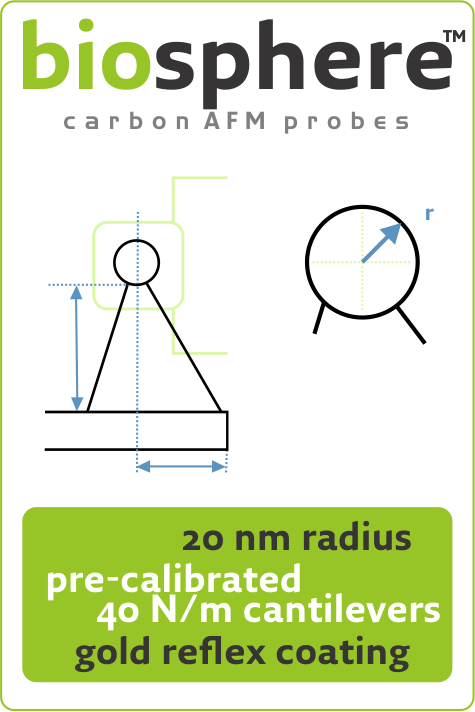

Season’s Greetings from NANOSENSORS™ AFM probesThu Dec 22 2022


50 years ago, wow!Wed Dec 14 2022


Understanding the Nano-Indentation Deformation Behavior of PolycarbonateWed Dec 14 2022
- Title: Molecular deformation mechanism of polycarbonate during nano-indentation: Molecular dynamics simulation and experimentation
- Authors: Daiki Ikeshima, Kazunori Miyamoto, Akio Yonezu
- Publication: Polymer
- Publisher: Elsevier
- Date: 31 May 2019
https://www.nanotools.com/blog/understanding-nano-indentation-deformation-behavior-of-polycarbonate.html
#AFM #metrology #topography #microscopy #nanotechnology #AFMProbes #spm #SPMProbes


Chemically characterizing the cortical cell nano-structure of human hair using atomic force microscopy integrated with infrared spectroscopy (AFM-IR)Thu Dec 08 2022


Happy birthday Prof. Quate!Wed Dec 07 2022


Thank you all for visiting our NanoAndMore USA booth at this year’s Materials Research Society - MRSFri Dec 02 2022


BudgetSensors® Tap300Al-G AFM probes used in a studyFri Dec 02 2022


NanoAndMore USA booth no. 311 is all set up and we're exited to welcome youMon Nov 28 2022
Materials Research Society - MRS MRS Fall 2022 Conference and Exhibit.
https://youtu.be/jvVANnajnFg


Happy ThanksgivingThu Nov 24 2022


Photoinduced Charge Transfer and Trapping on Single Gold Metal Nanoparticles on TiO2Tue Nov 22 2022


HQ:CSC38/Al BS and HQ:CSC38/Cr-Au ultrasoft silicon AFM cantileversMon Nov 14 2022


World Science Day for Peace and DevelopmentThu Nov 10 2022


Capturing and Analyzing 2D-Materials’ SEM and AFM Images on the Same Sample LocationTue Nov 08 2022
- Title: Advanced Hybrid Positioning System of SEM and AFM for 2D Material Surface Metrology
- Authors: Jaeryong Kim, Donghwan Kim, TaeWan Kim, Hyunwoo Kim, ChaeHo Shin
- Publication: Microscopy and Microanalysis
- Publisher: Cambridge University Press
- Date: June 9, 2022
https://www.nanotools.com/blog/capturing-and-analyzing-2d-materials-sem-and-afm-images-on-the-same-sample-location.html
#AFM #metrology #topography #microscopy #nanotechnology #AFMProbes #spm #SPMProbes


Piezoelectric property of PZT nanofibers characterized by resonant piezo-force microscopyMon Nov 07 2022


OPUS 160AC-NA AFM Probe used in a recent studyThu Nov 03 2022


BudgetSensors® ContGB-G AFM Probes used in a recent studyMon Oct 31 2022


Male-female communication enhances release of extracellular vesicles leading to high fertility in DrosophilaFri Oct 28 2022


New Avenues for Coexisting Perovskite Phases for Photovoltaic and Light-Emitting ApplicationsFri Oct 21 2022
- Title: Enhanced Stokes Shift and Phase Stability by Cosynthesizing Perovskite Nanoparticles (MAPbI3/MAPbBr3) in a Single Solution
- Authors: Muhammad Munir, Jinglan Tan, Ramis Arbi, Pedro Oliveira, Elisabeth Leeb, Yolanda Salinas, Markus Clark Scharber, Niyazi Serdar Sariciftci, and Ayse Turak
- Publication: Advanced Photonics Research
- Publisher: John Wiley and Sons
- Date: 07 July 2022
https://www.nanotools.com/blog/new-avenues-for-coexisting-perovskite-phases-for-photovoltaic-and-light-emitting-applications.html
#AFM #metrology #topography #microscopy #nanotechnology #AFMProbes #spm #SPMProbes


MACC1-Induced Collective Migration Is Promoted by Proliferation Rather Than Single Cell BiomechanicsWed Oct 12 2022


Toward Single-Atomic-Layer Lithography on Highly Oriented Pyrolytic Graphite Surfaces Using AFM-Based Electrochemical EtchingSun Oct 09 2022

















